#All Characters Who Resemble One Another For Style Functionality
Note
Sorry if this is a weird question but what is your opinion about how monsters reproduce? Especially skeleton monsters and others who have different types of shapes and features.
i think there's a bird monster who hand delivers all monster babies to their respective parents who looks like your stereotypical 60s union organizer. she brags about being storklift certified and goes on long unprompted rants on capitalism and the alienation of labor
#undertale very much suffers from the cartoon wide issue of We Have A Cast Of Wildly Differing Inhuman Character Designs But The Families Are#All Characters Who Resemble One Another For Style Functionality#that's obviously something toby didn't venture in with his worldbuilding#so my answer as a rule is: whatever's silliest while throwing in as many puns as physically possible#i have a funny idea to continue along this line but also i have to study maths now#so meanwhile if anyone can come up with a punny name for her it would make me very very happy#because so far I've come up with nothing#answered asks#undertale#OR to quote a fandom classic: ''...mmmmmmmmagic''
366 notes
·
View notes
Text
Background paintings in Ikevamp and why they matter

...even if you are not familiar with art.
Warnings: minor spoilers for all routes, though I tried to keep it as vague as possible
Time to talk about background paintings in Ikemen vampire because…why not?
First, let me warn you that the following is nothing but a theory based on some visual resemblance. While it may occur that Ikemen designers wanted to hide a few Easter eggs, it's also fair to mention that sometimes the sky is blue just because it's Sunday morning, and that’s all.
Nevertheless, one detail may hint at the former statement being true. And this is because there’s a significant difference in how different paintings are shown in the game.
Some of them are blurry, overdark or too bright. While we can distinguish some unclear silhouettes, the rest is on our imagination.



For example, it seems that the first picture is the natural landscape (probably, sunset in the forest) as well as the second one with the Ionic style columns being placed in the center of a garden. Still, we’re not sure.
But the thing is it doesn’t matter. The amount of details the viewer is given is too small for us to make any art-historical assumptions. Based on these mere images we can figure out neither the artist who painted them nor the narrative. Therefore, these paintings have only a secondary function of background decorations and proof of demonstration of their owner’s wealth.
On the contrary, there are paintings that we can easily detach because their creators are too famous to be unfamiliar with. But even within this scope of paintings there is a slight differentiation due to the way they are incorporated in the game design.
Some of them have been revived by the hands of geniuses who once created them. This is the case of Leonardo’s Study of a woman’s head and Study of Hands

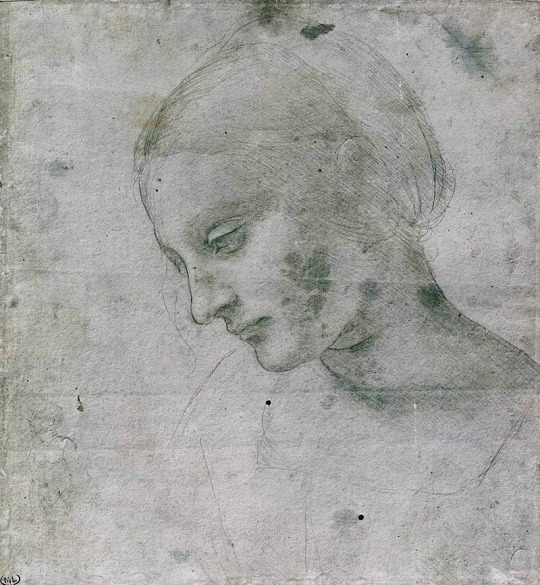
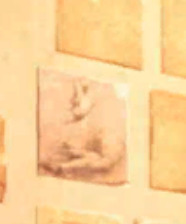

or Vincent’s Sunflower and the Olive trees



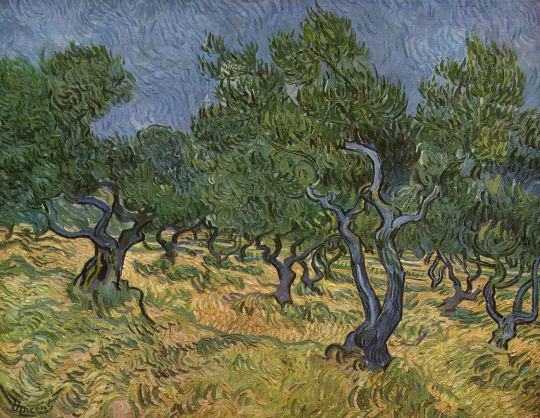
While it’s easy to reduce the meaning behind this design decision to simple hype, I think that it also serves as a visual representation of the suitors' character traits. What is the point of redrawing the painting that was already brought to life a long time ago? For Vincent it means years, for Leonardo - centuries. My guess is that for artists like them it's never enough. Life is too beautiful to be captured once and forever. A woman’s face is never a mystery solved. While for many people it’s okay to achieve a goal and forget about it the exact minute they are done, for geniuses like Leonardo and Vincent it’s always different. You must improve. You have to work further. There is always something new an artist’s eye can capture. That’s why they painted it again, again and again.
Let's move to another group of paintings. Spotting The Starry Night in Theo’s room is not a surprise because we know that, first of all, they’re brothers with Vincent, and, secondly, Theo is an art dealer.

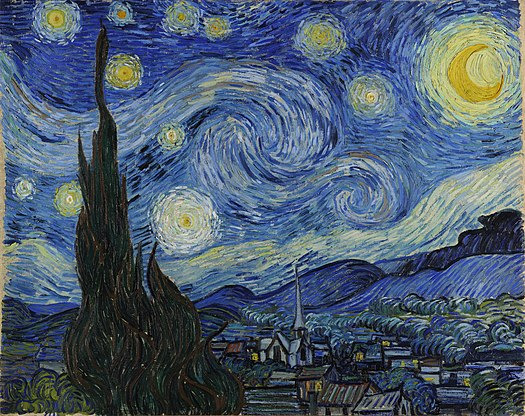
What deserves to be brought into focus is that this work is regarded as the elder Van Gogh’s magnum opus. Sure, you can argue that the real Theo and Vincent thought little of this painting, calling it “a failure”. To which I reply that, again, this is a game for numerous people across the world, including those who are not familiar with art history. For many of us The Starry Night is viewed as one of the most popular art works, a special work, a valuable one. Therefore, by omitting historical accuracy Ikemen writers and designers try to achieve something more contributing to the plot - they try to evoke certain emotions. Putting the art of such great significance in the room of one of the brothers should be a clear indicator of the amount of respect and love the two of them share. Describing the emotional bond between them is mainly the prerogative of writers. But sometimes game design plays no less if not more meaningful role in the process of us as readers getting familiar with characters. The painting here becomes a subtle part of the plot as it highlights certain prerequisites of their relationship and prepares us for what is going to come next.
The latter is especially relevant to Vlad's route. The female portrait in the pureblood’s room is what takes background paintings in Ikevamp on a fundamentally new level - the level of plot-forming core.

Unlike those paintings I mentioned at the beginning, these ones are no longer a substitute for the room decor. Instead, they serve as a device that pushes the plot forward. It accumulates three major points that are relevant to the plot:
It adds the mystery element for triggering our curiosity. The portrait is ‘faceless’, and even though we all see the resemblance in features, there is this ‘if’ element. What if they decided to go with a classical Dracula plot? Eternal vampire loses his lover and waits for her to be reborn? Is this MC? Why can’t he remember her face?
The portrait itself allows us to get for a second into Vlad’s head and understand his feelings towards the mysterious woman. Vlad drawing her portrait is caused by the act of kindness she showed him. His entire motivation is connected to the single painting. She was the one who he wanted to be with. In order to do so, he had to become strong, to accept his tragic loss and move forward. The portrait serves as a silent reminder about what was his goal and why he chose the path he chose.
It circulates the narrative. At the beginning, MC faces the challenge of being the third one in the relationship with Vlad and his unknown lover. She questions the identity of that unknown counterpart of hers and secretly wants to learn more about her. By revealing the truth of Vlad’s past and their connection, MC figures out who was the woman in the painting which in some way pushes her to find enough strength for making a certain groundbreaking decision.
Finally, there is the third group of paintings that possess what I call ‘potential meaning’. These paintings maintain the main features of the two previous groups, namely, vague silhouettes combined with a rather clear narrative that somehow increases the possibility of them being more than a decorative object.
Take a look at the two paintings in Vincent’s room. In comparison to all other paintings these ones differ not only in terms of shape but also in terms of color. The lines seem to be more fluid, and the color palette is dominated by ochreous, blue and black which is typical for East Asian classical ink art. By taking a closer look, you can actually see the vague outlines of the sea and shrouded in mist mountains in the background. Personally to me such landscapes together with a specific composition angle remind of Hokusai’s Thirty-six Views of Mount Fuji which can be a great allusion to Van Gogh’s obsession with Japanese prints and their role in his artistic career.



The huge painting in Comte’s living room has been haunting me for years, I shall admit. It portrays a marine landscape with a single boat chasing the wild waters in the dark or right before the sunrise. When talking about marine art, the first person that comes to my mind is Ivan Aivazovsky. Yet, it is evident that Aivazovsky’s style was pure romanticism with heavy realistic elements, whereas this painting looks like it's more about light and colores rather than clear and precise lines. And also this sun, this strange orange sun..that can be spotted only in Claude Monet's Impression. Sunrise.
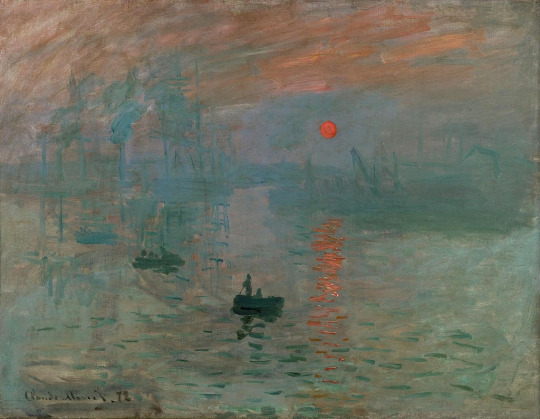


The mansion’s copy is a darker mirrow image of the original work. Nobody knows why Comte chose this painting for the mansion, but isn’t it a bit of irony that the painting that praises France, the country that suffered from the war with Prussia and was on its way to revitalisation, is located in the house that is about to face the battle between the lesser vampires and their haunters or rather the figurative war of two different morals (we are yet to know about it, though)?
Another version is that the painting serves as a metaphoric description of the character. In various routes MC mentions how Comte reminds her of the sun that made manifest, and everything supports this claim to be true, from his golden eyes and hair, to the brightness of the room and..paintings that symbolize the master of the mansion.
Finally, I wouldn't forget about the massive backlash Impressionists had to face at the early stage of the movement’s existence. It was only until the 5th Impressionist exhibition in 1880 that the artists finally got praised by critics. Just a bit more than 10 years before the MC’s appearance. However, we know that the creation of the mansion had taken place before this event. So, my point is that probably Monet’s painting was purchased by the greater vampire during the times when Impressionists were still harshly criticized by the Salon. And if so, the display of the painting that represents the les misérables of the art world speaks so much volume about Comte’s character and devotion to fulfill what he perceives as his noblesse oblige - to support those in need, to help them reveal their talent no matter what social class they belong to.
The game room’s central painting is another amusing detail as it’s completely out of mood. Playing cards, watching chess games or taking any other light leisure activity with a glass of brandy in your hand, you rarely expect to raze your gaze from the table only to stare at the image of ruins. Yet, this is what we get here - a typical capriccio painting like those of Alessandro Salucci and Leonardo Coccorante.



Capriccio artists dared to do something new in the history of art - they put real archeological signs into fantasy surroundings, sometimes from the same time period that the artists lived in. To an extent, they brought the ancient past and allowed it to live in the future, which is not a bad allusion to the original purpose of the mansion’s creation.
And here is what we can spot in Shakespeare’s room. At first, I didn't think much about this painting in Will’s bedroom but something felt odd. And then I understood.
You see, there’s this famous Vincent’s work named Cafe Terrace at Night. The painting is created from the north eastern corner that allows us to see the starry night without facing an obstacle in the form of the cafe's roof.
But this is how the modern cafe looks from a different perspective. Yellow elongated building with two wide niches that serve both as windows and entrance.

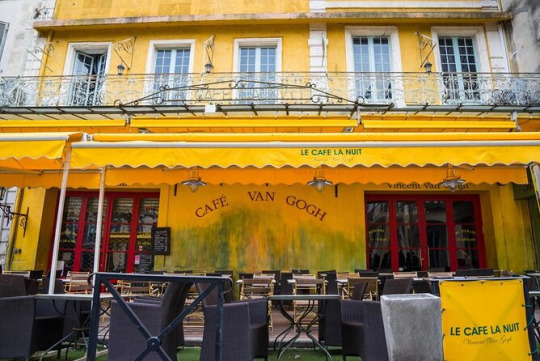
Do you see it, right? RIGHT?
I headcanon that Vincent was so eager to spoil his new friend with a present that he decided to redraw his favorite work and give it to the bard. But being an empathetic and observant one, Vincent immediately figured out Will’s admiration of everything unique and rare, so he decided to create a completely new version of his own painting instead of just redrawing it from the same angle as he did with sunflowers.
Aaand this is what we get in the living room. Random at first sight, the composition of various unrelated pictures actually makes sense. The most evident one is, of course, the image of theater curtains. What else should we expect to see in the manor of the great Bard of Avon? The same curtains, by the way, appear in almost every scene where MC and her suitor are invited to Shakespeare’s play.


Just a small detail, but I think this is one of those rare occasions when we can actually name the place Ikemen writers took inspiration from (apart from, of course, Louvre and the University of Paris). What helps us here is the curtains over which we spot golden metal lambrequin with a cartouche that imitates the image of the sun.
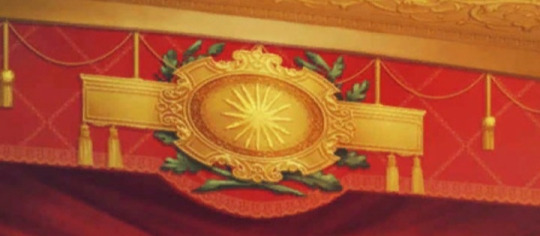
Such a prolonged lambrequin with the sun image (in honor of Louis XIV, the Sun King and also the father of the Paris Opera) in the center actually exists only in one Parisian theater - Opera Garnier, where in 1888 Shakespeare’s Roméo et Juliette was staged.

Just to make sure, look at the curtains in some of the most popular theaters that existed during the historical period in Ikevamp - Théâtre du Châtelet or the Opéra-Comique. You won't find a similar one.
Two last possible Easter eggs may be related to the two historical objects that existed during Shakespear’s era. The first one is still connected to the curtains for as you see, there were rumors (modern archeological findings prove them to be true) that the first venue of Shakespeare’s plays was called ‘the Curtain Theatre’.
And the second thing I want to point at is two images of the chair. Honestly, I highly doubt that a person like Will who has an almost narcissistic obsession with expensive staff would put a painting of such low value in his private apartment. But I can understand it, if this is not an image of some random piece of furniture but the well-known Shakespeare’s Courting Chair, wherein, according to William Henry, ‘the bard was used to sit, during his courtship, with his Anne upon his knee’.
Anyway, I hope it wasn't too much. Thank you for reading!
#ikemen vampire#ikevamp#cybird#ikemen series#ikevamp shakespeare#ikevamp vincent#ikevamp comte#ikevamp vlad#ikevamp theo#ikevamp leonardo#ikemen le comte#ikemen leonardo#ikemen theo#ikemen vincent#ikemen shakespeare#ikemen vlad
293 notes
·
View notes
Note
Tell me your hcs for Jason the Toymaker, Julius the Dressmaker and Candy Pop? Please and thank you💕💕💕
I will only do Jason since I don't know enough about Candy Pop and I don't want anything to do that that Diet Coke Walmart Chinese copy yaoi Jason and their weird ass creepy ass annoying ass lying ass creator.
Headcanons for Jason the Toymaker
For what I understand about the original character, Jason is a sort of interdimensional demon. Or at least that's what he's gonna be in my AU albsakab
His store shows up apparently out of nowhere on almost forgetful and hidden locations so it doesn't get too much attention apart from his prey. A dark alleyway, a lonely street, an abandoned park, sometimes shamelessly in the middle of a highway or the middle of nowhere.
It is a sort of door towards his realm. At first like a regular old-styled toy store filled with trinkets and colorful toys of all kind, but behind the cashier place where Jason Meyer would assist you as a customer, behind that door where he shows up from. There could be a regular living room with a kitchen and some stairs that probably lead to a bedroom. Or there could be an endless corridor of gradually grotesque toys, or a twisted garden where his worm friend waits his dinner, or just plain black darkness.
He poses as a human, a pretty handsome young lad who enjoys building toys and has his own magic store where he apparently lives.
His usual meals are kids who wander into his toy palace and lost people who want a present for their lovely children or partner. Everyone who enters that place will never return.
He has been doing this for ages. Spotted from Victorian England to Cold War Russia. Feeding and searching all over the world for who knows what, and never seeming to be satiated.
Though he enjoys making toys and terrify his customer, his main focus is "The Chosen One".
Nobody really knows what or who is this "Chosen One", but it's something that Jason is always talking about. We can guess that it could be a young woman, since he is always praying after them, acting like a real charmer so he could lure them into his twisted wonderland and make them... His friend?
Like I said. No idea what he's actually doing.
Not even Candy Pop or April Fools know what is up with that man. Not that they care anyway, at this point it just seems like babbles from an old grandpa.
Anyway. There isn't much to talk about when it comes to Jason. What you see is what you get. He's not secretive, just someone who doesn't shout his sad backstory or evil plans just like that. It doesn't seem like a lot anyway.
His biggest mystery is his "Chosen One", he never gives a clear explanation of what he's talking about. Almost like he doesn't even understand it either. All he describes is a person to be with, someone who would listen and understand him, someone who would stay with him no matter what, who is willing to give and do everything for him.
Maybe the concept of love is to much for an interdimensional monster.

Now let's talk about what's easier for me to write.
Jason is not a demon or an angel. He's more of a mythical creature(? A monster from another dimensional plane, a magical dark being. It's hard to describe him, his true self exists on a different plane of existence from our world, with different concepts of reality and physics we could never understand as humans.
To have some sort of vision, his magic resembles a lot of that from Wonderland or Howl (from the Howl's Moving Castle movie)
His true form is unknown, when he gets angry he still manages to keep his human form while he's losing his composure. We can see hints of how it would look like though, with his burgundy hair turning silver white and his hands turning into black monstrous claws.
His magic isn't as strong outside of his store. Neither is he. Due to the difference in the metaphysical planes of our world and his he can't fully function and is very tiring to keep up with the many laws of physics we have. He is perhaps as powerful as a God inside his own place but he's nothing more than a pretty stage magician on ours.
Jason has no relations to Slenderman or the mansion. He's on his own, living in his magic toy store place behind a weird door he magically makes appear out of thin air.
He does have relationships with Candy Pop, April Fools and the Laughing Jacks (Jack and Jill), along with some connections on some circles of hell. But so far he has nobody living with him besides his toys.
He's overall a very toxic person. He's a "lying possessive control freak" as stated in his wiki. And he loves the attention, he acts like a princess. He doesn't like it when he's not the focus on the conversation and will make people go out of their way to do as he pleases because he doesn't feel like having dirt on his new shoes.
Even though he has the power to clean himself up.

Second request is done. I had a lot of fun writing this since the idea of a Wonderland-like magical being gives me a lot of creative freedom, though I struggled a lot since Jason is one of those characters I don't know much of. I am a Slenderbros girly, I can't help it.
But he is done. A lot shorter, earlier and messier than Jeff's because of what I just said. But done! I'll work on his design soon, but I won't promise a lot since I'm pretty in love with Jason's original design already ^^
#creepypasta#creepypastas#creepypasta headcanon#jason the toymaker#jason meyer#jason the toymaker headcanons#the toymaker
48 notes
·
View notes
Text
So, whenever I talk of my WIR Next Gen AU, people tend to ask me about a particular child. So to answer those questions...
Steep
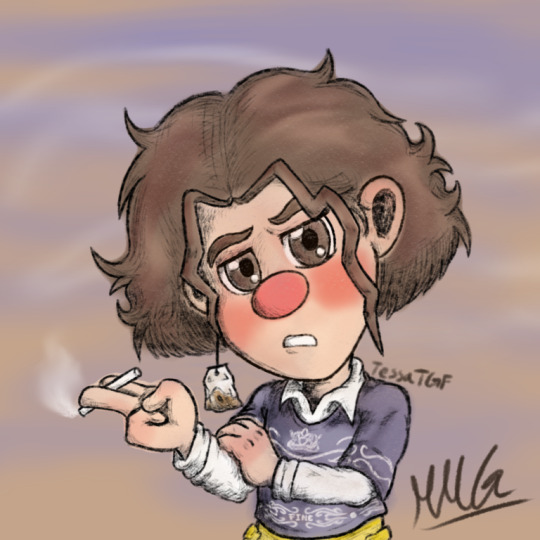
This is one of my first digital renditions of Steep. He is another child from my Next Gen AU - Wreck-It Ralph: Modified.
When Steep was younger, he was founded by the now adult Sugar Rush racers. Assuming he was a glitch that spawned into their game, the Sugar Rush racers figured that by helping to raise this child they would make amends to the wrongs they did to Vanellope. So they all adopted Steep, worked out plans for each household to swap around and care for him routinely, and Steep officially became the first of the Sugar Rush Next Gen children.
Unfortunately, as Steep got older, he began to grow more into his features. He began to garner resemblance to the old tyrant that was King Candy, though no one knew how or why. So this begs the question: "Who is Steep?" In truth?... Steep is King Candy respawned!
After the incident at Diet Cola Mountain, the game made an attempt to respawn the tyrant, but since the virus was still attached to him, the game had to detach his code to remove it and try to backup all his data to a separate box. This all happened just before Vanellope reset the game, and once she did, King Candy's code was destroyed in the middle of the backup process. This left a code box that had the necessary character assets, the voice, but not the objectives, personality, or the memories. The game had to bring him back younger than intended to keep him functioning and to help him develop the elements he was lacking. To this day, Steep still does not know of his past life...
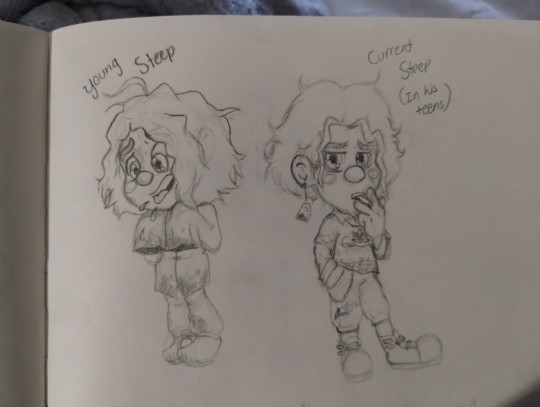

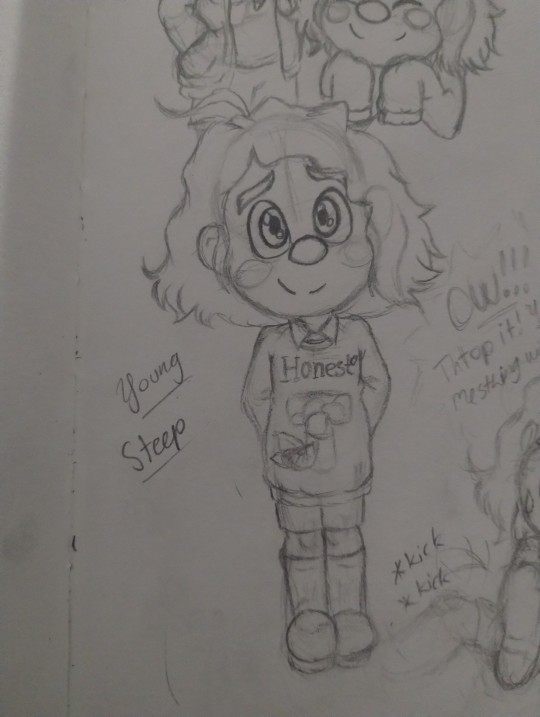
Aside from that, Steep is currently a defected teen, who is still trying to find and express himself through various styles of clothing and music.- though he takes more of a liking to retro 70s/80s styles. His Sugar Rush theme is based on teas and sugar cubes.
Additional details:
When he first spawned, it was before the racers installed the mod that let them grow their families, so he was the first child any of them had!
He is the 2nd oldest of all the Sugar Rush kids; he was 1st oldest, but Vanellope adopted a boy that was slightly older than him.
Though Steep is not inherently a glitch, he does have one- or should I say, he has a defect! Defects prevents elements of videogames from behaving the way that they should; they are more common in game objects, but rare in actual characters! When a character has a defect, they will experience great pain when trying to perform an action that they should do, but that their coding contradicts with. Since Steep still has all of the baselines of Turbo's code, but all of it is inactive or incomplete, Steep's defect will electrocute him for: Attempting to operate a vehicle, getting envious, getting competitive, trying to remember old memories, etc.
Despite what one would assume, Steep is a kind, outgoing character. He thinks of all the other Next Gen kids as his cousins; the only Next Gen kids he seems to have tension with are Florence Von Schweetz and Deidamia Calhoun.
He can often be seen smoking candy cigarettes, putting tea leaves in his snacks, and drinking seltzers, ciders, or Irish teas. Despite his substance use, he does not promote it. He actually wants to quit, but has not gotten the will to do so.
He has a kart. The adult Sugar Rush racers made him one by hand. It resembled a large teacup with biscuit and crumpets when he was much younger as a birthday gift. Unfortunately, he never got to use it because of his defect. It lays collecting dust...
When he is not spending time with the other racers at their house, he hangs around in his little shack. The adults made it for him when he was getting older so that he could have a place to rest and settle in on the weekends or during arcade times.
And if you are curious about what his glitch, or what his "defect", looks like, be expecting a slight visual representation of it later...
#wreck it ralph#art#character bio#alternate universe#sugar rush next gen#next generation#sugar rush#steep#young steep#kingcandy#modified#sugar rush racers#sugar rush speedway#character variant
15 notes
·
View notes
Note
Ok, I just spent the last few minutes doing nothing but staring at Kara in that DWTS piece and I don't see it AT ALL. Beyond being blonde I see absolutely no resemblance between your Kara and either Sara or Ava. It's just not there.
It's a gorgeous work of art. If anon needed to look at Lena’s hair (ignoring the fact both characters are clearly named in the piece and the caption) to figure out the blonde was Kara I suspect that they have worse eyesight than me without my glasses, and I’m not legally or safely allowed to drive without them.
And you would think that humans as a species would have figured out by now that “Not to be [incredibly insulting in one way or another] but [is incredibly insulting]” is not a thing that is ever ok to say to anyone at any time. “Not to be a dick but” then don't. Just stop talking and cut your losses there. Creatives in particular have already said it to ourselves a million times in our heads, we don't need outside confirmation that our self-doubt was right all along.
I had a chapter I posted with a note “this is the most nervous I have been about any piece of writing I have ever done. I hope it doesn't suck too much.” and then got a comment “Since you asked for criticism [here are all the reasons this sucked and one minor ‘compliment’ at the end]”. Like exactly what in that note says “yes I welcome people ripping apart something I spent the last several months agonizing over”? Nearly made me quit writing altogether. I do not understand the way these people think and hope I never do.
i’m sorry that happened to you! making something and sharing it with the world will always be two very different joys to me — creating is a given but publishing it is a choice, and especially when you first get started, putting your work online is an incredibly vulnerable & incredibly brave thing. i know how devastating having even one person receive it like that can be — good for you for not letting it stop you!
to be honest, i'm still amazed by how much the culture in the fandom spaces i’m in subscribes to the ‘don’t like, don’t interact’ idea. my first experiences with publishing fanwork (fic) happened in the early 1700s, when getting feedback was rare (most websites didn’t have a built-in function to respond, so you’d only get people going through the trouble of emailing you their thoughts directly) and when it did come, the comments leaned toward the brutally honest, like you had presented your work to a classroom of your peers ready to pick apart the things they thought needed work. (in other words, there were a lot of shit sandwiches.)
the thing is that anonymous critiques like that — while having their value, especially when english was still a foreign language to me! — will never be very effective, because they’re coming from a random stranger whose credentials are entirely unknown. i’ve always learned the most from friends whose work i admire and who i know are genuinely interested in helping each other improve. those are the people i want to be learning from (and with)!
i’m sure you know this but it bears repeating how much of what we love about fanwork is exceedingly subjective, and the more you find your own style, the more you realize there’s not one way to ‘do’ art (whatever kind) correctly. no matter how ‘good’ your work is, someone will inevitably be unhappy with your choices.
so i assume most of the anonymous criticism we do receive is from people who aren’t writers or artists themselves, and that they’re clueless both to what they’re talking about and how their words will land. it’s made it much easier for me to shrug off their remarks and continue doing what i love. i hope you feel that way too! i hope we have an easy week ahead with plenty of time, energy and inspiration to create whatever we choose to!
#thank you for the thoughtful ask#& sorry about the late reply!#i'm in hermit mode plotting out this rootin' tootin' new au#i get a little obsessive. you know how it is!#ask me things!#pyresrpgear
13 notes
·
View notes
Text
Everything you need to Know about Threads by Instagram

Parent company Meta, which also owns Instagram, entered the social media market this week with the introduction of a new product called Threads, a competitor to Twitter.
As of Thursday morning, the business reported that Threads had 30 million users, making it the most rapidly downloaded app in history. The app reportedly garnered five million sign-ups in its first four hours and now has around 70 million users worldwide.
But just what is this Threads thing? How does it function, and how simple is it to sign up? Here’s all you need to know about the app that’s been dubbed the “Twitter killer” by its critics.
What is Threads by Instagram?
Threads is a brand-new app developed by the same company that brought you Facebook, Instagram, and WhatsApp. The network resembles Twitter in many ways, including a feed of mostly text-based updates (although users can also post images and videos) where instantaneous conversations can take place.
Threads’ format is similar to that of Twitter in that users can publish brief messages and then like, repost, and comment on those messages.
Key Features of Threads
Posts can contain up to 500 characters
Videos can be 5 minutes in length
A link to the post can be shared on other sites as well
Threads allow users to unfollow, block, limit, and report profiles
If an Instagram account is blocked, it will also be blocked on Threads
You can add Threads posts to your Instagram story
Users have the option to limit who can mention them or respond to their comments
Threads Vs Twitter
Similarities
Short-form content
Chronological Timeline
Features that encourage interaction
Differences
A close-knit group of pals can enjoy a distinctive experience with Threads while Twitter serves as a forum for free speech that encourages dialogue between people, organizations, and public figures throughout the world.
The ability to search for certain text or phrases is absent from threads whereas hashtags are an essential component of Twitter and are used frequently.
Messages within threads are connected together in a linear style, producing a structured and sequential discourse with a 500-character limit whereas Twitter has a character limit of 280 characters.
Users can have an organized back-and-forth by replying to individual messages in Threads whereas users on Twitter can interact with one another’s posts by liking, retweeting, and replying to them.
Messages inside a thread are presented in chronological sequence, facilitating the reading and navigation of the discourse whereas on Twitter, users can look through tweets from the accounts they follow, peruse tweets based on a hashtag, or investigate current trends.
A user can post up to 10 items in a single post. They can also upload videos of up to 5 minutes in Threads whereas on Twitter, a user can only add up to 4 items per tweet and a video of a maximum of 2.20 minutes.
At the moment, Instagram accounts are required for the use of Threads and vice versa whereas to access Twitter, one needs only a username or an email address or phone number.
How to create an account on Threads?
Step 1: Get the Threads app for your Android or iOS device. If you type threads into your Instagram search bar you’ll get a direct invitation to download the Threads app.
Step 2: Once you’ve downloaded and launched the app, you’ll be asked to sign in using your Instagram credentials. If you are already logged into Instagram on this smartphone but still can’t see any of your accounts when you open Threads, try restarting the app.
Step 3: Following the viewing and selection of an Instagram account, you will be invited to edit your Threads profile. Instagram handles the import of your username.
Step 4: Your Threads profile can include a bio and a custom link, or you can transfer your Instagram information by tapping the transfer from Instagram option.
Step 5: The screen with privacy settings is up next. Here you have the option of making your Threads profile viewable only to you or to the general public. Threads’ privacy settings can be different than Instagram’s. To proceed, choose between a Public Profile and a Private Profile.
Step 6: Next, you’ll be asked if you want to follow the same accounts you already follow on Instagram. You can choose to follow specific accounts on Threads, or you can tap Follow All to automatically follow everyone you’re already following on Instagram.
When you’re done here, your Threads account will be active and ready for use.
How to Use Threads?
Step 1: If you want to start a new thread from anywhere in the Threads app, just hit the Create symbol in the bottom-center of the screen.
Step 2: Start writing in the provided space. If you need to add more text than is allowed in the text area, just select Add to thread.
Step 3: You can choose who can reply to your threads by tapping the Anyone can reply button at the bottom left of the topic creation screen.
Step 4: You can choose to restrict replies to only those you follow or those you mention or to leave them open to everyone.
Step 5: To make your comment public, click the Post button in the right-hand corner.
How to Follow and Unfollow Users on Threads
Step 1: Select the search bar at the bottom of the screen.
Step 2: You can search and follow any account by typing its name into the search bar or by selecting it from the list of suggested accounts.
How can Threads benefit businesses?
If you’re an entrepreneur, using Threads gives you a chance to connect with your audience on a more human level, which can only help your company’s reputation and sales.
Threads and other similar apps make it easy to communicate with a small but dedicated fan base by providing them with access to behind-the-scenes content, updates, and discounts.
That wraps it up, then. All of your questions concerning Instagram’s Threads feature have been answered. It’s rather remarkable how this app has created a niche for confiding in close pals and sharing private moments. To check out our reel on Threads, click here.
By the way, we are on Threads too!! Click here to follow us!
Read more about Everything you need to Know about Threads by Instagram
0 notes
Text
MARS DAWN RESEARCH...

2012s ark, they resemble the style of a cruise ship that is designed to combat the harsh icey waters of Antarctica or any cold sea climate, it's got a sci-fi theme to it as well looks like a ship off of Star Citizen. (A video game about space)

The USSCS Alien Covenant ship was designed to fit 2000 colonists and 1,140 embryos, the purpose of that vessel was to scout out new planets to call home

Two by two animation style is has low quality animated characters and is very childlike in its animation, but that's the intended style so I can let that go, but the animals themselves are quick and have a slight cartoonist style to them.
Catastrophes...
The moon makes are planet more liveable by maintaining our planets wobble on its axis which leads to a more stable climate, it also causes tide's by leading it using it's gravity. The moon supports the wobble of the earth using it's gravity to stabilise the Earth in its orbit.
Unreal and real animals...
Examples of real and real animals are the chigeon or pickons (chicken and a pigeon) it was believed that seeing this animal back in the day would have meant u lost Ur sight, Beefalo (cow and a bison) a big fluffy cow designed to survive cold climates and bred to have better quality meat, and Lygers or leopon (Lion and leopard) these creatures are rare and can only be artificially bred, they have the usual characteristics of a lion's mane mixed with the spotted pattern of a leopard.


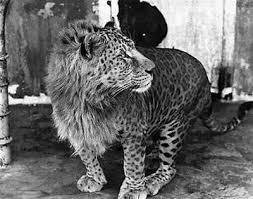
Behemoth... A behemoth is referred to as being a big unstoppable force of God's chaos and usually takes the form of something big scary and with horns. In the Bible Behemoth, in the Old Testament is a powerful, grass-eating animal whose “bones are tubes of bronze, his limbs like bars of iron” (Job 40:18). Among various Jewish legends, one relates that the righteous will witness a spectacular battle between Behemoth and Leviathan in the messianic era and later feast upon their flesh.

The Tundra...
Tundra is the coldest of all the biomes. Tundra comes from the Finnish word tunturi, meaning treeless plain. It is noted for its frost-molded landscapes, extremely low temperatures, little precipitation, poor nutrients, and short growing seasons. Dead organic material functions as a nutrient pool.


Apocalyptic landscape art

Bottomland...Flat land along a river, lying a few feet above normal high water, often consisting of alluvial deposits and naturally fertile. It's very ideal for plant life growth since it has most things needed for flora to grow and other creatures to prosper.

THE DARK CRYSTAL...
The dark crystal is a fictional Jim Henson film, "on a fictional planet, the damaged Dark Crystal marks the onset of the age of chaos. If the crystal is not healed during the great conjunction of the three suns, the evil Skekses will rule forever"

"The Gelfling are a race of elf-like creatures native to the planet of Thra. The term Gelfling derives from the term "Ghel-lflainngk" roughly translates to "those who live without knowledge of the future," according to The World of the Dark Crystal documentary." In the film the Gelfling is a boy who is accompanied by another Gelfling with wings so that they could put back the shard of the dark crystal.
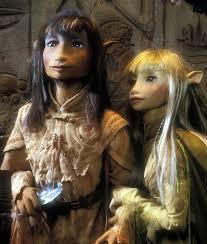
"The Skeksis are a fictional species that serves as the main antagonists in the 1982 film The Dark Crystal and its related franchise. The word "Skeksis" serves as both singular and plural form for this species, with the singular being pronounced and the plural." The skeksis themselves are the rulers of the world Thra in the film and take on the appearance of a big ugly bird most time's, they guard the dark crystal and in the film are greedy, disloyal and basically just bad.

"The urRu, more commonly known as Mystics, were a race of natural wizards that lived during the Age of Division. Like the Skeksis, they were offshoots of the urSkeks, personifying their wisdom and spirituality, but lacking their passion and innovation." The mystics were the literal opposite of the skeksis having a more clean and docile look to them, and In the end of the film the two join together Into a type of tree alien.
Brian Froud art...
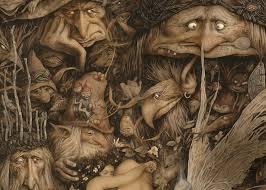
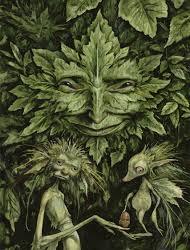
His work consists of mystical tree people, that also have fairies, goblins, gremlins and dwarfs, basically a bunch of creatures that would look like they could be from the medieval period.
0 notes
Text
A Review of Animal Sculptures
Creating a miniature garden within the coffee desk is eve Making a miniature garden on the espresso desk is the eve
Once they satisfied AASD Group relations director Paula Foreman in the park, the First strategy was to complete something like a bench, she said.
Rejoice kids with present-day sculptor Bronti's timeless picture of Jesus smiling and welcoming the little types. Understanding that Jesus taught which the kingdom of heaven belongs to includes these. Also known as "The Smiling Christ Statue," Bronti made him more than a two-foot-superior sculpt to honor Among the most joyful facets of Christ s ministry.
The look of the Toscano Young Gardeners Statue completes a glimpse of the garden with its distinctive structure. This statue incorporates a style of two Young children Functioning in the garden with garden instruments; They may be named Rebecca and Samuel. Made from resin, this statue is hand-painted and it has a light grey finish. The resin design guarantees maximum energy and durability.
At 21 inches tall, the pair is Solid in superior-good quality resin which has a faux stone end, mimicking The traditional lion sculptures standing guard at castle gates all over the world.
youtube
Now for a far more historic vibe, you may have a Roman and Greek bust sculpture designed. Marble humanoids quickly come to feel basic and complicated to start with look.
The balancing best piece is perfectly weighted to manage gentle breezes or gusty winds. This piece mounts over a pole that’s included and stands fifty-two inches tall when set with each other.
This exclusive property decoration adds a playful appeal Absolutely everyone will like it. These statues are a 3-piece list of see, listen to, and speak no evil Easter Island tiki statues. These charming statues could read more and be exhibited alongside one another or spread out through your garden, yard, or deck. The statues are crafted applying weather- and UV-resistant magnesium oxide content.
Your spirit will soar on the assurance of hope inscribed Within this contemplative cherub statue. With feathered angel wings plus a book with readable text, this inspirational toddler angel sculpture is grounded in everlasting religion in everyday life's attractiveness.
An alternative to applying the above-mentioned Guidelines is to utilize Haddonstone’s Masonry Weathering Tint. This simple-to-use h2o-dependent formulation adds character to cast stone. A person's coat will insert an antique search, or extra levels might be applied to build up a larger depth of color.
Martin Truck Bodies is donating the parts of metal along with the funds for your laser cutting for that ribbon.
These Chinese garden lions have stood sentry at palaces, temples, and houses of the elite for centuries. This pair is manufactured from bonded stone by having an antiqued stone complete.
Our mom and infant ducks add allure to some flower beds, porch, or routes. This Duck Relatives with Mother and Three Toddlers Established is hand-painted to resemble copper with verdigris highlights. Every single lifestyle-sized duck strikes its pose and wears another expression, lending temperament to any Room.
Increase an enjoyable and distinctive ingredient of appeal for your garden, deck, dwelling, Business office, or any outdoor Place with this particular lovely fowl. Makes an incredible gift for people who like our feathered friends.
0 notes
Text
hermes mini kelly 23
Mini Pattern
We’re no stranger to the sumptuous confines of Kylie Jenner’s luxury designer-filled handbag closet containing uncommon pieces from labels like Chanel, Fendi, and Balenciaga. Talking in regards to the rarer styles… In addition to multiple sizes of the Kelly bag, Hermes carries on to supply limited edition variations of the type 12 months after yr. wikipedia handbags The most desired restricted edition Kelly, is no doubt, the Himalaya Kelly. The bag is made of the pores and skin of the Nilo crocodile, rendered in a subtle coloration that resembles the photographs of the magnificent Himalayan mountains. Initially founded as a saddlery and equestrian items maker over a hundred and eighty years ago, Hermes has developed right into a fully-fledged luxurious powerhouse. Continuing to maintain up its heritage, practically all of the designer’s current day items feature a refined equestrian nod in one way or another.
All rights reserved - All the brands on this web site belong to their homeowners. Investing in certainly one of our Kelly or Birkin bag is all the time a great investement. Average worth of the Kelly and Birkin bag has been multiply by two in 7 years. First, please notice that my telephone within the high picture is an iPhone eleven Pro in the smaller dimension . I selected this phone specifically in anticipation of the Mini Kelly and it suits fantastic. I do are inclined to take it out of its case after I put it in the bag.
phoenet.tw replica mini kelly The Sellier Kelly’s have stitching on the surface, whereas the Retourne Kelly’s are stitched on the inside. Did you understand that the Hermès Kelly has been around for means longer than the Birkin? The historical past of the Kelly bag dates back to 1892, when the first ever prototype of the bag was launched. Initially, this bag was meant to function a saddle holder and was known as “Haut à courroies”.
Your good bag could already be on the market, ready for you. If you are planning to part with the undeniably eye-watering sum for a real style classic that will preserve its value, learn Vogue’s guide to purchasing an Hermès bag first. The Hermes Constance is another house favourite dating again to the Nineteen Fifties and is the top of pure class. The Constance was designed in collaboration with Catherine Chaillet who named the bag after her baby daughter. An simple wearing shoulder bag that options the house’s signature H-shaped clasp, the Constance became a favorite amongst Hollywood’s elite as a result of its versatile and compact design.
Comments Please notice which items you need to in trade. The worth might vary between gadgets of a special dimension or colour. He designed a trapezoid form with two triangular gussets, a cutout flap, a handle and two facet straps, and with it he introduced the home into the period of boldness and modernism. Kanye West showered Julia Fox and her closest friends with Birkin baggage for the actress’ birthday.
Her character turns into torn emotionally between her two lovers, performed by Crosby and William Holden. She was again dressed by Edith Head to suit her role in the film, initially appearing in fashionable clothes, shifting to ordinary-looking cardigans toward the end of the movie. BRAND OFF is a shopping web site operated by K-Brand Off Co.,Ltd. It deals in classic items and vintage collections, both new and used. Comes with signature Hermes field, shoulder strap, and sleeper.
This magnificent bag is also one of the SUPER RARE Hermes luggage that collectors and investors need to get their palms on. Every from time to time, Hermès will release a model new end with little fanfare, stunning bag devotees and fashion insiders with one thing surprising. This was the case with the Trimaterial model, launched in 2014, which featured a combination of Swift leather, Clemence leather, and the distinctive Ostrich leather on the body of the bag. Existing in only two colorways, one in Cobalt hues and the other in Vert and Taupe shades, the bag isn't seen IRL, except amongst A-listers. Collection of professional-chic everyday Kellys—some opt for harder-to-find colorways.
This approach is seen in almost all of Hermès’ leather goods, and entails the use of two strands of their proprietary beeswaxed cotton thread fed through in a double saddle stitch. To add the finishing touches to the design, a clochette, two keys, and cadena lock are added for added security. Despite this hierarchy, the Kelly bag has been around for lots of a decade previous to its youthful sibling, and the continuation of its recognition right now is a testament to its enduring, traditional type. This offers the Kelly bag with a more elegant look and offers the option of carrying it both in your hand or crossbody.
There is measurement, color, and leather to take into account. However, earlier than you presumably can even begin to consider these options, you have to resolve whether or not the Birkin or the Kelly is the type for you. The guide below is designed to give you all the data needed to make that call. You have my dream bag the Hermes mini Kelly in the vert you've with GHW . My dream bag however can not get one as Hermes don’t wish to promote me a bag . It’s so unhappy as I’d like to have a group of Hermes bag and in some unspecified time in the future purchase the Himalayan berkin .
To celebrate its 45th anniversary, the Kelly watch took an authentic approach to the mastery of time, borrowing the emblematic padlock from the eponymous bag. Side straps, swivel clasps and padlocks harness wallets or purses, combining beauty with operate. Reinvented in a quantity of variations, allusions to the Kelly now adorn small leather items. Jean-Louis Dumas, Executive Chairman of Hermès, was a master of graceful drawing. He lived pencil in hand and breathed mischievous creativity.
0 notes
Text
Content for Bespoke Publication
https://creativepro.com/the-bauhaus-designer-paul-renner/
Paul Renner was born 1878 in Germany. He was a graphic designer, typographer, type designer, painter, and teacher. From 1908 to 1917 he designed books for a living for the Münich publishing trade. While he was never directly affiliated with the Bauhaus movement, in the early 1920s he became an advocate of its aims and principles and became a leading proponent of the “New Typography”.
In 1926 Paul Renner became the principal of the Printing Trade School in Münich, and he was also the co-founder and Director of the Master School for Germany’s Printers. (Meisterschule Für Deutchlands Buchdrucker). Renner published a booklet titled ‘Kulturbolschewismus’ in 1932, in which he criticized the Nazi’s cultural policy. In 1933 with the consolidation of Hitler’s powers in Germany, the Nazis dismissed him from the school as an intellectual subversive, a ‘Cultural Bolshevist’. Renner arranged for his friend and member of his staff, George Trump, to take over the directorial position to avoid an unpredictable external appointment by the Nazis. Another noted member of his staff at the school was Jan Tschichold.
The same year, the Nazis also shut down the entire Bauhaus design institution in Berlin, thus creating a wave of immigration to the United States. One of the founders of the Bauhaus movement, the Hungarian painter and designer László Moholy-Nagy was one of the immigrants, who shortly after his arrival founded the Chicago Institute of Design based on the principles of the Bauhaus.
Renner’s seldom mentioned condensed typeface, “TOPIC” or (Steile Futura) features alternate rounded characters for the letters “A”, “E”, “M”, and “W”. (1953-55)
Futura is a sans serif face designed by Paul Renner between 1924 and 1926. It is based on geometric shapes which became representative visual elements of the Bauhaus design style of 1919-1933. Futura was commercially released in 1927-1930 and it became a cornerstone of the ‘New Typography’ classified as Geometrical Modernism. Form follows function became the key words and careful reasoning constrained all the character shapes to their utmost functional simplicity. With Futura, in typographical terms, the industrial revolution had reached its logical conclusion.
Initially, Futura was issued by the Bauer Foundry in six weights, a condensed version in three weights, and an Inline. Renner’s typeface family provided the right typographical tool for the professional designer and it became a popular choice for text and display composition. Even today, advertising typographers often use the combination of Futura Light/Book and Futura Extra Bold because of the design’s stylish elegance and commanding visual power.
Under licence, Deberny & Peignot issued the same type in France under the name of Europe. American Typefounders and Mergenthaler Linotype countered with a close imitation of Futura, named Spartan. Twentieth Century is another typeface which was ‘inspired’ by Futura. Futura Black was added later, and it is quite distinct from the rest of family, in fact, it closely resembles a stencil type. The Intertype Futura Extra Bold was designed by Edwin W. Shaar in 1952, and the Futura Extra Bold Italic was added in 1955 by Edwin W. Shaar and Tommy Thompson. Paul Renner died in 1956, and his original drawings for Futura are now on display at Fundición Tipográfica Neufville, Barcelona.
The Futura family members are: Regular, Light, Light Oblique, Light Condensed, Book, Book Bold, Book Oblique, Medium, Medium Oblique, Medium Condensed, Bold, Bold Oblique, Bold Condensed, Semibold, Semibold Italic, Extrabold, Extrabold Italic, Extrabold Condensed, Inline, Display and Black.
Renner’s other design, which is generally unknown, is the “TOPIC” or Steile Futura family. It is a condensed sans serif face with rounded alternate characters for the letters “A”, “E”, “M”, and “W.” The family consists of Medium, Medium Italic, Bold, and Bold Italic. TOPIC was introduced by the Bauer Foundry in 1953-55.
0 notes
Text
Sukellos -Sucellos
God of Gaulish Celtic Mythology
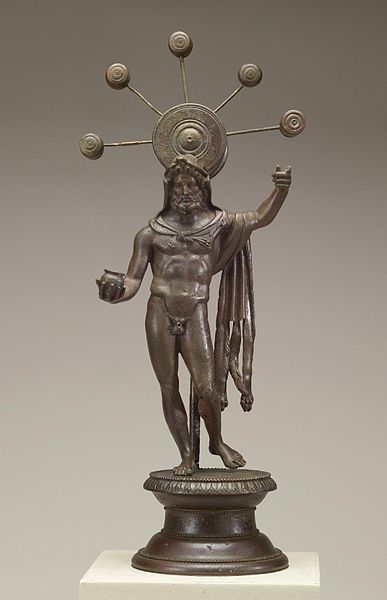
Walters Art Museum in Baltimore, United States of America ( This statue of Sucellus is the earliest known depiction of the god (circa 1st century AD). It was found in a Roman dwelling in France and stood in a private sanctuary (lararium).
Celtic god of agriculture,
forests and alcohol...
Characteristics
Latin name: Sucellus
Main function: God of life, death, crops and flocks
Place of origin: Gaul
Period of Origin: Celtic and Gallic Antiquity
Paredre: Nantosuelte - Nantosuelta
Equivalent(s): by syncretism Dagda, Sylvain, Thor[1]Symbols.
The name of the god is said to mean "good hitter" or "hit hard". The theonym is composed of the prefix su- which means "good, good" and cellos which designates the hammer (or striker)[3].
Judging by the number of his representations (more than 200), Sucellus is one of the greatest Gallic gods[4].

bronze statuette at the National Archeology Museum in Paris.
This god is known mainly in Gaul and all the elements concerning him (representation on a Unelles coin, some inscriptions and bronze statuettes) are from the Gallo-Roman period.
He appears to be old and bearded, dressed in the Gallic style of a long blouse tight at the waist and tight breeches, sometimes with boots. In addition to the mallet (or the hammer), he is represented with food utensils: cauldron, keg, wine amphora. It happens that the mallet is replaced by a sickle and that the foot of the god is placed on a keg.
He is sometimes accompanied by a dog.
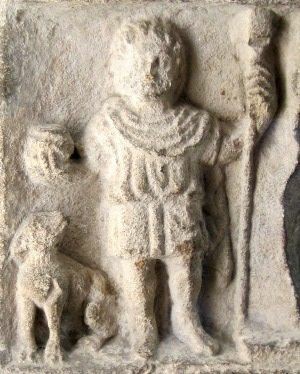
Relief of the Gallic Silvanus on an altar in Nîmes. The god carries his distinctive mallet and olla. A dog is next to him.
Syncretism
At least eleven Sucellus inscriptions are known[5], mostly in Gaul. An inscription (RIB II, 3/2422.21) was found at Eboracum (modern York) in Britain.
Sylvanus
In an inscription found at Augusta Rauricorum (modern Augst), Sucellus is identified with Silvanus[6]:
In honor (em) /d (omus) d (ivinae) deo Su /cello Silv (ano) /Spart (us) l (ocus) d (atus) d (ecreto) d (ecurionum)
The syncretism between Sucellus and Silvanus can also be seen in the work of Narbonne Gaul[7].
Thor
Sucellos bears strong similarities to the Germanic god Thor.
Archaeologist Jean-Jacques Hatt puts forward two possibilities:
• The resemblances between the two gods could result from a common origin dating from the Bronze Age, when the partition between Celtic or pre-Celtic cultures on the one hand and pre-Germanic on the other hand is not yet clear between North Germany. South and West[1]. The separation between the two groups would then date from the beginning of the Iron Age, more precisely from the peregrinations of the Hallstattian warriors, bearers of the long sword[1].
• Another possibility, at a much lower period (3rd-2nd century BC), the Gallic Sucellos could also have contaminated the Germanic Thor like the Celtic Teutates the Germanic Odin[1].
Hatt also notes that these two theories are not exclusive, an ancient Celtic-Germanic origin of Sucellus and Thor, as between Teutates and Odhin, could have facilitated exchanges and syncretisms between the two pantheons, the Germanic and the Celtic[ 1].
A god of life and death
He is the only Gallic god who has a somewhat infernal character[4].
Like the Irish Dagda, Sucellos kills and resurrects with his mallet, which he holds in his left hand. He stands straight, his foot resting on a barrel, a symbol of survival.
He is the Gallic equivalent of the Irish god Dagda, but not an exact replica. Indeed, as a dispenser of wealth, protector of crafts and agriculture, he falls under the third productive function (the other two being the priestly class of druids, and the class of warriors), whereas Dagda, in the Irish tradition, belongs to the first function, called priestly.

The sucellus of vienna
A god of crops and herds
Sucellos is a rural deity, a pastoral god, protector of crops and herds[8]. Sucellos is a "provider of food[9]" god. He is the holder of prosperity, symbolized by that other attribute which is the cauldron, in his right hand. He is a god of nurturing nature, forests and plantations[10]. Sucellod is also considered like the god of beer

Beer ad (consume in moderation)
Her consort is Nantosuelte, which is a representation of fertility. Sucellos and Nantosuelte are associated on an altar discovered in Sarrebourg and on which we can read the following inscription:
Deo Svcello /Nantosvelte /Bellavsvs Mas /se Filivs V(otum).S(olvit).L(ibens).M(erito).
This can be translated: "For the god Sucellos and Nantosuelte, Bellausus, son of Massa, willingly and rightly fulfilled his vow."
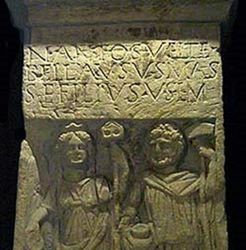
Altar of Sucellos and Nantosuelte in Sarrebourg.
Sucellos seems to have been particularly honored in the Rhineland and in the eastern part of Gaul, in Narbonne, during the Gallo-Roman period. An inscription has also been found in Britain.
• He was assimilated to the Roman god Sylvain, god of vegetation[12], especially in Gaul Narbonne.
• Paul-Marie Duval hypothesized a closeness to another Latin sovereign god, Dis Pater[13].
• Anne Lombard-Jourdan analyzes it as an avatar of the god Cernunnos[14].
• Strong links between Sucellos and Thor have also been put forward[1].
• Bernard Sergent compares him to Vishvakarma.
-------------------------------------------------------
contrary to what I could see as absurd, his feast day does not take place on November 11, the date dedicated to Thor, but his celebrations in Gaul took place on March 20 or 21, days of the spring equinox because he was a Agrarian God who largely dispensed food to men, he was celebrated with the aim of having good harvests in the year.
---------------------------------------------------------
Notes and references
• 1 / ↑ a b c d e and f Jean-Jacques Hatt, Myths and Gods of Gaul, vol 2
• 2/ ↑ Paul-Marie Duval, The Gods of Gaul, Paris, Payot, 1993, p. 62.
• 3/ ↑ Xavier Delamarre, Dictionary of the Gallic Language, Paris, Errance, 2003, p. 113, 282, 283 (ISBN 2-87772-237-6).
• 4/↑ a and b Paul-Marie Duval, Great Gods of Gaul [archive], Publications of the French School of Rome, Year 1989, 116, pp. 223-234
• 5/ ↑ Jufer and Luginbühl (2001), p. 63.
• 6/ ↑ AE 1926, 00040 [archive]
• 7/ ↑ Duval (1993), p. 78.
• 8/ ↑ Félix Guirand, General Mythology, ed.
• 9/ ↑ Paul-Marie Duval, The Gods of Gaul, p. 63.
• 10/ ↑ Jean-Paul Persigout, Dictionary of Celtic Mythology, ed. of the Rock, p. 280, Monaco, 1985, (ISBN 2-268-00968-8)
• 11/ ↑ Philippe Voluer, The Big Book of Beer in Alsace, Editions Place Stanislas, 2008. p23
• 12/ ↑ Record of the National Archaeological Museum, Saint-Germain-en-Laye.
• 13/ ↑ Paul-Marie Duval, The Gods of Gaul, p. 64.
• 14/ ↑ The origins of Carnival, ed. Odile Jacob, Paris, 2005, p.196 (ISBN 2-7381-1637-X).
Bibliography
• Stéphanie Boucher, "The image and functions of the god Sucellus", in The world of images in Gaul and neighboring provinces, Caesarodunum, 23, 1988, p. 77-85.
• Paul-Marie Duval, The Gods of Gaul, Paris, Payot, 1993, 169 p. (ISBN 2-228-88621-1)
• Bernard Sergent, "Sucellus and the barrel", in Marco V. García Quintela, Francisco J. González García and Felipe Criado Boado dir., Anthropology of the Indo-European World and material culture. Proceedings of the 5th international Colloquium of Anthropology of the Indo-European World and comparative Mythology, Budapest, Archaeolingua, 2006, p. 61-80.
• Raymond Christinger and Willy Borgeaud, Ancient Swiss Mythology, Geneva, Georg-Musée d'Ethnographie de la Ville de Genève, 1963, 318 p. (pages 147-214)
#sukellos#sucellos#celtic god#dieu celtique#alban eilir#équinoxe printemps#druidisme#druidism#gallish god#gallic god#dieu de la fertilité#dieu gaulois#celtic mythology#mythologie celtique#spring equinox#spring#ostara
33 notes
·
View notes
Text
The Culture of the Demon World
One part of The Promised Neverland that I always wanted to learn more about was the demons and their culture. Demons are a whole new race with their own language, religions, traditions, food, and history, and I want to learn more about their society. So, I decided to do a bit of research on a few specific aspects of the demon world. After writing everything down and connecting the pieces while trying to remain true to canon, I finally have something clear enough to share with you all.
Without further ado, I present to you my analysis of demon culture.
Part One: Clothing
Just like in real life, the clothing demons wear depends on their social status and wealth. The middle and lower-class demons wear loose, flowing clothes with wide collars and sleeves. They most likely do this just in case they aren’t able to eat human meat and maintain their form; baggy clothes won’t tear if the demons start to degenerate. This is why the wealthy demons wear tighter clothing. Tight-fitting outfits show that you can afford plenty of human meat and that you aren’t worried about degenerating.
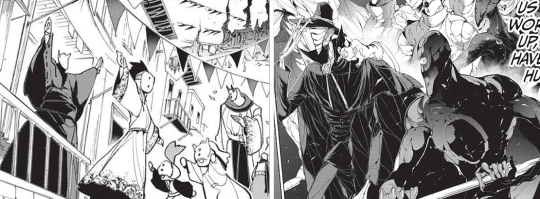
Many demons, both poor and rich, wear long, layered clothing, but it’s hard to tell if this is a societal standard or a byproduct of cold weather. Almost all of the demons we see are wearing long-sleeved tops and ankle-length bottoms, as well as a jacket, shawl, cape, or scarf. However, the feet and hands are almost always uncovered.
A major part of demon clothing is, of course, their masks. This extra page explains the styles and functionality of the Goldy Pond demon’s masks:
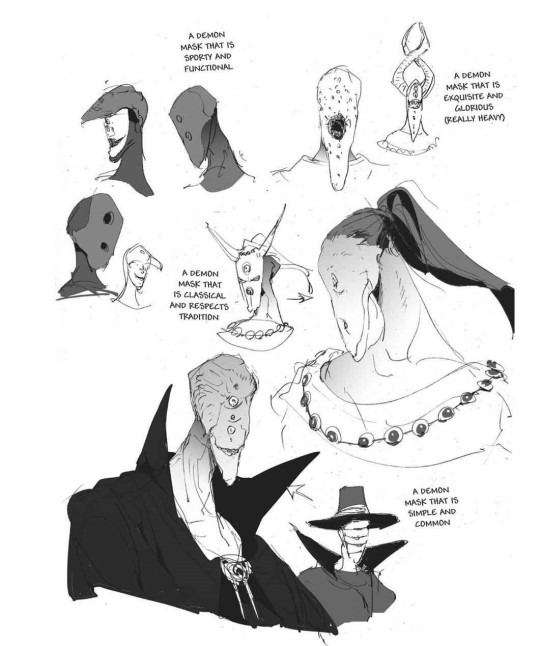
Like the rest of their clothing, wealth plays a part in demon’s masks as well. Detailed masks with large horns, like Luce’s, are worn by rich demons who want to flaunt their wealth, while lower-class demons wear simple, paneled masks with short horns. Demons who want a more functional mask might choose one without horns so they don’t get in their way. The aristocrat demons also have a unifying feature between their territory’s masks to differentiate themselves from the leaders of other territories. Whether or not your mask shows your mouth appears to be a personal preference since Legravalima, Mujika, Sonju, Awla, and Mawla all have uncovered mouths despite the character’s drastic differences.

Another detail I would like to point out is the material of the masks. Most demon masks are likely made of a material similar to clay, but there are a few demons with special masks that appear to be made out of something else. Nous and Nouma, for example, have athletic masks coated with shiny material that’s probably similar to polyester. However, it was Legravalima and Sonju’s masks that interested me the most. Legravalima’s mask is smooth, glossy, and seemingly made out of metal. A metallic mask is likely a sign of royal status and immense wealth. This explains why Sonju had a metallic mask as a child, and why he doesn’t have one now. When he was a prince, Sonju wore a shiny mask with a design similar to Legravalima’s. After running away with Mujika, he grew out of his mask and now wears a clay one of the same design.

This might just be the art style of the series changing over time, but I also find it interesting that Sonju’s mask suddenly becomes glossy in chapter 156 during the battle at the royal capital. It’s his first time stepping foot in the palace since he ran away, and it’s as if his mask is suggesting that returning to the palace has given Sonju his royal status back.

Part Two: Architecture
In many ways, the architecture in the demon world reminds me of places like the Sant Francesc Church in Spain and Royal Ontario Museum in Canada. As time goes on, old buildings are expanded and improved with modern additions to accommodate the changing world. This can be seen in the paradise hideout, where a newer building was constructed next to the original settlement.

The old, traditional demon buildings are made of clay and other types of stones. They don’t appear to have many windows, and the few windows they do have are holes without window panes. Many of the older buildings were carved out of mountains or trees, or at least rest atop a mountain with steps carved into the side. This traditional style of demon architecture is similar to old Pueblo architecture and adobe homes.
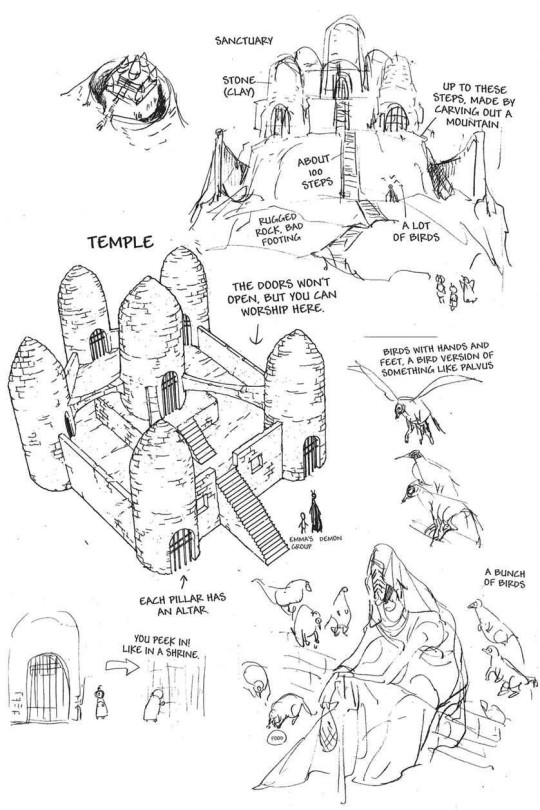
The newer demon architecture likely came into style sometime before Goldy Pond was built, seeing as Goldy Pond has buildings similar to those in modern demon villages. It resembles the European Tudor style with its grid window panes, timber frames, and sloped roofs. The walls were probably made using the wattle and daub technique and painted white or cream. Some of the buildings have stone foundations, but unlike the old style of architecture, the stones are laid like bricks. Buildings made using the new style of architecture also have shutters, awnings, and Juliet balconies.
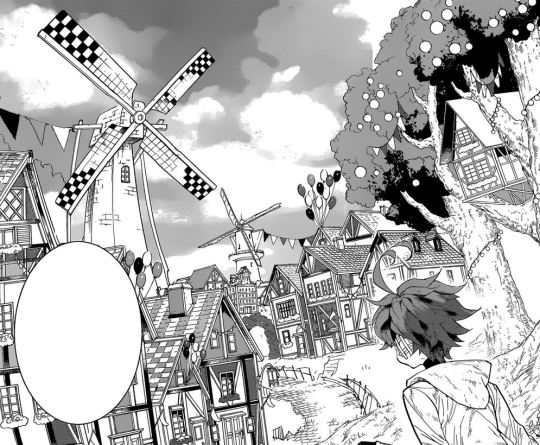
This picture of the royal capital’s streets perfectly shows the mixing of the old and new architectural styles:

Here, you can see the original clay buildings with the balconies, awnings, and wooden frames of the new style added on. The buildings in the foreground have open windows while the ones further back have grid panes. One of the structures on the right is built in the style of the older demon homes, but it uses modern stone bricks and balconies. This blend of architecture helps show the development of the demon society through the years.
Part Three: Food
Human meat is the most important food in demon culture since it’s what keeps the majority of demons from degenerating. I won’t be talking a lot about the farms and human meat in this post since it’s already been explored by the manga and people smarter than me. If you want to read more about demons and human meat, I recommend this post by the-silliest-idiot and this translation of the fanbook, particularly the Q&A sections.
As explained in the manga, the appearance of demons changes depending on the type of meat they eat. The aristocrat demons eat human meat, Parvus eats monkey meat, and the demon horse Sonju rides eats horse meat. As explained in the fanbook, humanoid demons will lose their human appearance if they don’t eat human meat, but monkey demons like Parvus can retain their appearance for a while. To keep themselves from degenerating or changing forms, humanoid demons don’t eat a lot of meat other than the human meat from the farms. When the demons do eat other meats, they eat bugs, fish, and birds, probably because those animals are difficult to change into.

While it’s unclear if demons eat the plants in the forest, we know that there are plenty of edible berries, nuts, fungi, and other plants that the human escapees eat during their travels. Demons also have a variety of fruits, vegetables, and nuts that they grow and harvest. In just these two panels, we can see that the demons have their own versions of pears, hazelnuts, pineapples, kiwi, and mangos (the mangos seem to be popular in the royal capital).

All demons, regardless of wealth or social status, appear to have equal access to all food except human meat. Lower-class demons get low-quality meat, but the same berries and nuts being sold at street markets are present in the Tifari offering.
Part Four: Language
Unfortunately, I’m not smart enough to decode the old demon language. In the words of the fanbook, “Sugita created demon god's name, but every other text from the demon language that appeared afterward was Posuka's creation.” The language was made up by Posuka, and I’m not sure if there’s enough dialogue to translate a full alphabet. The old demon language looks like a combination of Japanese and Enochian, but that’s all I can gather from it. It’s also unclear if the language has a written form.
However, the old demon language isn’t used anymore. The language died out for two major reasons; a general lack of knowledge and to separate language from the old faith. The aristocratic demons know the language well enough, but we don’t see many commoner demons speaking it. The modern demon society writes in English, as shown by the signs at Goldy Pond, and it’s likely that they also speak English despite the story being written in Japanese. There's also a chance that the demons speak Old English since the promise was forged during medieval times. If this is true, then the aristocrats and heads of the farms could have a more modern accent because they often talk to people from the human world.
Part Five: The Arts
Sadly, we don't know much about art in the demon world. The promise was made around the 11th century, so art in the demon world is likely reflective of that time. I can only assume they have their own literature, art movements, and music, but it's mostly speculation. One thing I noticed is that the demon world has a lot of embroideries, whether it be on the edges of a cape or banners inside the palace. This fits with my theory of medieval Europe-inspired art and languages. During medieval times, top layer garments such as coats and cloaks were commonly embroidered along the hemline and cuffs. This kind of embroidered clothing is worn by many demons throughout the series.
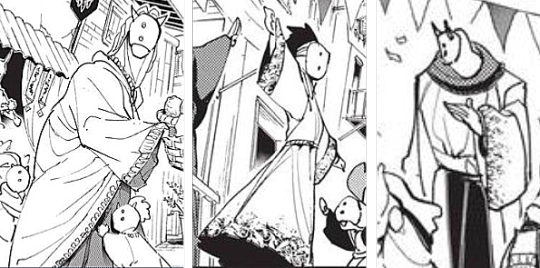
Banners, tapestries, and flags were also commonly created by artists during medieval times. Lines of flags are seen throughout the demon world, and a few buildings in the capital have banners hanging outside. The palace has a few banners of its own, though they're fancier than the ones in the capital streets.

Damask fabric is another example of demon artistry being influenced by medieval Europe. Damask is a reversible fabric created by weaving. The royal demons seem to have jumped on the damask train before the promise was sealed because it can be found in many places throughout the palace. Most notably, Legravalima's dress is partially made of damask, though the silhouette is very different from that of a medieval damask evening gown. Damask was commonly used to make curtains as well, like the ones draped around the Tifari offering.
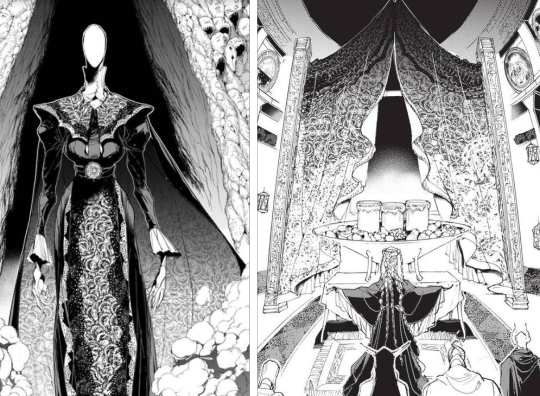
We don’t know much about literature in the demon world. The books we see were written in the human world and sent to the farms, but surely the demons have their own books and stories. Seeing as the rest of the arts in the demon world were inspired by medieval Europe, I can only assume that their books, fables, and plays are as well. Much of medieval literature was based on religion and chivalry. There were also many fables and myths derived from old stories and religious texts. Demon children probably read many stories about the Evil Blooded, the runaway prince, and heroic knights who protect the demons from harm. There likely are many stories written in the old demon language as well. Similar to Latin and Old English in the Middle Ages, the old demon language was probably the main written language until the 11th century, when the demons began using English as a primary language.
I imagine that Anglo Saxon, Byzantine, and Norman (ha get it) art heavily inspired art in the demon world. The palace is likely covered in tapestries and murals depicting historic events. Metal and tilework were probably once a major part of demon artistry, but the practices died out over time. Instead, many demon artists practice painting and embroidery. Pieces of art in the demon world would be very vibrant and colorful, especially the works displayed in the palace.
When it comes to music in the demon world, there isn’t much to go off of. We know that the farms have access to instruments and sheet music because of Leslie and Nat. Barbara also sings a Japanese children’s song in chapter 113. Unfortunately, we don’t get much information about music in the demon world outside of the farms. I assume that demons primarily play string instruments and piano because of their long fingers. They also have more fingers than humans, meaning they can make a variety of chords that humans can’t. More fingers also allow demons to add more strings to their instruments. Even though it’s possible that demons have their own special instruments, we know that they also have human instruments like cellos, trumpets, and pianos.

Conclusion:
There’s a lot more I wish I could talk about (mainly the elements of culture), but I’m stopping for now so this doesn’t get any longer. Feel free to correct me or add on anything I missed. If you made it this far, thank you for reading this incredibly long analysis of demon culture and I hope you have a great day.
#am I reading into this too much? yeah#the promised neverland#the promised neverland manga spoilers#tpn#yakusuko no neverland#ynn
76 notes
·
View notes
Text
Murakami and Ranpo
Some minor spoilers ahead for the third BSD LN, The Untold Story of the Founding of the Detective Agency." If you aren't concerned with spoilers, I did my best with summarizing the plot for anyone who hasn't read the novel.
In the third BSD LN, Fukuzawa and Ranpo are tasked with finding the culprit of an ominous death threat at a theatrical play. The threat is written as follows:
“An angel shall bring death, in the truest sense of the word, to the performer. —V.”
This threat fits perfectly with the play, which is a mystery play where each character gets killed by an "angel" who murders. However, the characters don't know if they're being killed by an angel or a regular person, because there's nothing supernatural about their causes of death (getting stabbed by a knife, poison, strangulation, etc.).
Each character was a former angel who had been banished from the celestial world, because they admired humans so much that God turned them into humans. Therefore, the characters in the play believed that an angel was sent after them to punish them for their sins.
This sets up two mysteries for us to follow:
1. The mystery of the real death threat, sent by "V" — who is the culprit behind it, who will they kill, and why?
2. The mystery within the play — is it an angel or real person killing each character, and why?
Paradoxes (and Things That Don't Make Sense)
The play is called, "The Living World is a Dream, the Nocturnal Dream is Reality," which is a quote from the real Edogawa Ranpo's work, but I couldn't find the exact source. The title proposes a paradox: reality is a dream, and dreams are reality.
Several other paradoxes present themselves in the story, but they appear most prominently in Ranpo's big speech where he solves the mystery of the play, and the murder simultaneously:
“The murder and the play’s story are connected on a deep level. This play reversed the tide of the narrative. A group of fallen angels tried to return to the heavens, but the angel of judgment tried to stop them. Meanwhile, the angel’s judgment was but a show, and the supposed victim, a human, faked it. The angel’s and humans’ roles were reversed, switching the judge and the judged. That’s the kind of play this was. "
"...the narrative is in reverse. Our structures have been swapped along with the victim and killer as well. In other words—he isn’t the killer, but a victim."
This reveal subverts the original expectation that the plot would follow two separate mysteries. Instead, the lines are blurred between reality and fiction, killer and killed, and dreams and reality because now the two mysteries are intertwined.
I think this part of the story is deliberately written to be confusing (or at least not very clearly explained) as to fit in with the themes found in Murakami's writing.
Who is Murakami?
Haruki Murakami is a famous Japanese author, and you may have read some of his famous works, "Norwegian Wood" and "Kafka on the Shore."
Since this is Bungou (Literary) Stray Dogs, Murakami makes an appearance in this light novel as the main actor of the play.
Before I go on to explain Murakami's role in the novel, I'll give a brief background on his real counterpart and explain how the theatrical play in the novel reflects the real Murakami's work.
Murakami writes in the genre of "magical realism", where the lines between fantasy and reality are blurred as magical elements are seamlessly incorporated into the story. I'll be using "Kafka on the Shore" as the main example for this point, since it's a great example of Murakami's expertise in magical realism.
In "Kafka on the Shore," there are 2 interrelated plot lines, alternating with each chapter, similar to the 2 supposed mysteries outlined at the beginning of the novel.
Like its moniker, "Kafka on the Shore" resembles a "Kafkaesque" style of writing due to its surreal elements that are bizarre and illogical in the rules of reality.
In an interview about this novel, Murakami said:
"Kafka on the Shore contains several riddles, but there aren't any solutions provided. Instead, several of these riddles combine, and through their interaction the possibility of a solution takes shape. And the form this solution takes will be different for each reader. To put it another way, the riddles function as part of the solution. It's hard to explain, but that's the kind of novel I set out to write."
The Outcome of the Play
In theme with Murakami's bizarre, magical-realism writings, several illogical events take place within the span of the LN:
1. Before the play even starts, Murakami (the character) and the rest of the cast completely disregard the death threat. Even though the logical and safe solution would be to reschedule the play, it is a very literal representation of "the play must go on" mindset.
2. Murakami gets stabbed mid-sentence, on stage by a white blade that magically disappears.
3. Murakami bleeds real blood and has no pulse, which would signify his death, but he doesn't actually die.
Despite all this, Ranpo is extremely good at observing various elements of a situation and putting them together to form a solution, much like how the interactions of "Kafka on the Shore"'s riddles form their own solution.
Ranpo appears on stage and makes an Oscar-worthy performance out of his announcement that reveals Murakami to be the culprit behind his own death. It doesn't make much logical sense that Murakami would fake his own death for a performance, but rather it's an action motivated by pure passion.
“I…,” muttered Murakami in almost a whisper. He raised his voice and continued, “I am an actor! I become someone I am not and live a life that doesn’t exist! My job is to expose what it means to be human! It doesn’t matter if I play the lead part or a minor part. It doesn’t matter if I am a villain or hero. I become them with every part of my body! There is no other job for me! This is the only way I can live!”
And here, Murakami reveals the final paradox of the play:
"But there is one thing that cannot be avoided while acting on the stage of life, and that is death! Death is not the opposite of life; it is life’s symbol and banner. However, it also provides a great paradox! Nobody alive has ever experienced it! That’s why to me, the greatest job of all would be performing the death of a person. Not death as a device or a mere convention, but real death that I could convey to the audience. That was the pinnacle of theatrical performance to me. And this is the outcome of my toil."
Murakami eventually gets arrested for the fake death threat and deceiving the police, among other things. The most notable moment after this comes in Ranpo's dialogue to Murakami:
“I thought you were amazing,” Ranpo suddenly said from behind as Murakami was being taken away. “I didn’t quite understand all of it myself, but I don’t think it’s something that just anyone could do. By the way, take a look at the audience. Look at their faces.”
1. Ranpo sees Murakami's act as something admirable, most likely because Ranpo appreciates a good mystery and had fun solving it.
2. Ranpo tells Murakami to look at the audience, to which he turns around and sees the faces of a broken audience who came to watch a play and instead witnessed a real not-so-real murder.
“You said your job was entertainment, right? But could you really call it that…when you look at their expressions?” For the first time, Murakami’s eyes showed a sign of weakness. “…I see.” A small voice, unlike what one would expect from a stage actor with a powerful voice, fell from the stage. “I was…only performing for myself.”
Murakami realizes that he traumatized his entire audience on his quest to reach the "pinnacle of theatrical performance." In his small world that consisted of just the stage, he failed to see the outside world and forgot to consider how his actions would impact others. It's also important to mention that it was Ranpo specifically who pointed it out to him.
The focus on the audience mirrors Fukuzawa's thoughts when Ranpo was giving his big speech before Murakami appeared on the stage:
Fukuzawa was at his wits’ end. From the playgoers’ point of view, the fact that people knew there was going to be a murder beforehand completely changed their view of the situation. Was it really okay to tell them that? But Ranpo showed no concern for the audience’s worries.
Ranpo, throughout the entire novel, is portrayed as this extraordinarily ordinary kid who means well but simply doesn't understand what others are thinking. He was taught that he wasn't special, but this only isolated him into his own tiny world, because the outside world was filled with things he didn't understand.
This leads to him upsetting a bunch of people by blatantly calling out things about them that shouldn't be called out, like the theater's owner Ms. Egawa, and even Fukuzawa at one point.
However, this moment when he calls out Murakami is pivotal because it shows how he's grown from this event. He's learned to be considerate of others. He's seen how he can upset other people with the things he says, and he's learned from that enough to show another person who's trapped in their own individual world.
Although Ranpo is depicted to be somewhat self-centered throughout this novel and even after it, Fukuzawa taught him that he isn't alone in this world. Because Fukuzawa showed compassion to Ranpo, a special fifteen-year-old kid who didn't know better in a world of monsters, Ranpo learned how to exist in a world where he was different from everyone else, and that was okay.
Thank you for reading! If you haven't read this LN yet, I would still highly recommend it because I didn't cover the entirety of the mystery, and it's a wonderful read to understand more about Ranpo and Fukuzawa's backstory.
#bsd#bsd meta#bsd analysis#bsd ranpo#murakami#bsd light novel#i actually read the LN a while ago#but didn't realize murakami was in it until i finished kafka on the shore
167 notes
·
View notes
Text
Mr. Genova: Instructions for Use
Hello there! I recently got to re-read Hetalia’s story about Napoleon in occasion of a trip in Corsica, and suddently remembered this adorable little guy. While there are a lot of wonderful people that took the mantle and tried to give character and story to what are actually just 2 sketches from 3y ago, I also noticed some disappointment (understandable) and…. misinformation from lack of context and historical knowledge about the topic. I know that seeing the 4th italian brother when maybe your country isn’t in yet can be frustrating, but trust me when I say that Genova is a very important character for many of the events that occurred between the middle-ages and WWII (does Colombo ring a bell?).
With that said let’s try to discover together who actually was is Mr.Genova!
Why Genova and not Genoa? Genova is the correct italian name of the republic/city while Genoa is it's english version and, incidentally, the name of Genova's most renowed football team. So just like for Venezia and Roma we'll keep the original pronunciation.
In this first part we’ll talk about Genova design
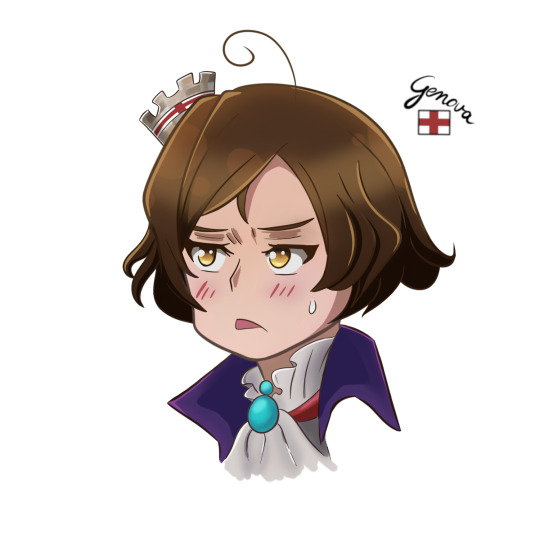
[Original sketch by Hima, I just polished and colored it to better convey my ideas about his design.]
I’ve heard people complaining that “he just seems like a fusion of Romano and France”, funnily enough not only the comparison is quite on point, but it’s coherent with Genova’s history and probably intentional on Hima’s side.
To understand what I mean let’s look at a little map of modern Italy

We can immediatly notice some things ->
1) Liguria (the name given to Genova’s historical territories after the city became “capoluogo di regione” in 1948) borders with France and Monaco. For all it’s life Genova had to fend against France and would often end under it’s dominion for brief periods; at the same time their vicinity favored a similar culture and language (with one BIG exeption we'll see another time): Monaco and Corsica, previously territories of Genova, retain a great resemblance with Ligurian when speaking their actual language, aka Corso and Monegasco. At the same time Ligurian presents some elements common in french that are actually absent in standard italian.
2) Genova is situated in front of the Ligurian sea and has open access to all of west-Mediterraneum, becoming the most important harbor in north-west Italy since it gained his autonomy from the HRE around 1096 A.D. Due to Liguria peculiar geografical conformation (no plains and the Alps-Appenines isolating Genova from the rest of north Italy, favoring a climatic bubble that makes the region a greener version of the south) our republic decided to limit it's expansion towards northen countries and instead focus on the Mediterraneum sea, becoming Spain and by proxy South Italy best commercial/political buddy till (almost) the end of it’s indipendent life.
3bonus) Yes guys Seborga is a little town in the Ligurian hinterland and was part of the Genovese republic. While Seborga's story is really interesting (might do a focus in the future) the general history and culture of the 2 is the same.
NOTE: every time I use the term “Italy” during any period pre 1861 consider it only as the geographical meaning of the peninsula (Italy as a country wasn't a thing till then).
PALETTE AND DESIGN
With this introduction in mind it makes sense for little Genova to have his hair styled similar to France and a darker shade compared to Veneziano. While the dark gray used by Hima could hint at both black and dark brown, the latter is by far the most common color in Liguria so I decided to go with that.
His eyes are anybody’s game to be fair, but I decided to be as faithful as possible to the average ligurian so, just like Feli and Lovi when Hima decides that his eyes aren’t olive anymore, brown/light brown is the most common color in Italy (+ we already have Seborga as the random flashy neighbouring brother).
To end our palette the skin tone could be an in between: probably darker that a Northener but lighter than a Southener (no mayor arabic nor germanic influences here)
CLOTHES AND ACCESSORIES
clothes -> nothing too important to say, the clothes are fit for the XVIII sec., they shows Genova’s status as a wealthy commercial republic and unofficial bank of Europe (yup, before Switzerland Genova had that role and it’s banks are considered the oldest in Europe). As long as the colors used aren’t too flashy everything is fine.
crown thingy(?) -> now this is where things become interesting. There are 3 possible options I could think as of why Genova, of all the possible accessories, has a crown when it wasn’t even a monarchy. Pick what you prefer or feel free to add your personal interpretation if you want.
1) money and superbia: as written before, during it's prime Genova was a wealthy republic, lending money to half of Europe and being the indiscussed queen of west-Mediterraneum (ofc Venezia was the queen of east-Mediterraneum, but that’s another story for another post). The city even got the nickname “Superba” to enanche the grandiosity and way too much pride of it’s people. A crown would be a fitting choice for someone who is probably a bit narcisist.
2) city status: in ancient paintings the personifications of countries and cities were made recognizable by the presence of a little crown on their head. Adding to that, in Italy to be a full fledged town or city you must receive a crown symbol to put on your emblem, maybe Hima is hinting at Genova actual predicament.
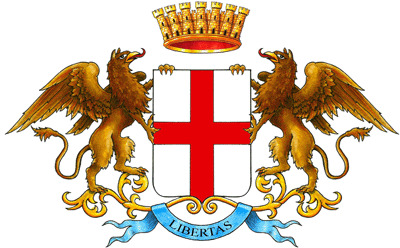
3) the Lanterna: I’ll admit the first thing I tought while looking at Genova was “that looks like a little tower”. A bit strange, but actually not farfetched; if you have ever visited Genova you’ll know what I mean when I say this city has a lot, and I say A LOT of towers positioned trough the historical center. The reason? To protect themselves from the French/Ottomans/eventual pirates, in the XVI sec. Genova decided to build a massive system of walls and towers that surrounded the city. There is also a specific tower that is considered the symbol of Genova itself “la Lanterna”. The Lanterna is the oldest Lighthouse still in function trough Europe; maybe if you glance at its modern look it doesn’t scream “tower”, but before it was semi-destroyed by the French army in 1513 A.D. Lanterna beared a striking resemblance to what Mr.Genova is wearing.
“MUGUGNO LIBERO”
Last but not least, the infamous pout that gave Genova the label of “Romano 2.0”. It’s not random, it’s not wrong, it’s such a toughtful and unexpected touch that Hima would be declared honored guest by any Genovese (and made me personally laugh like an idiot for an hour).
What Genova is doing here has a specific term in the local language, mugugnare!
What is “mugugnare”? Mugugnare is a peculiar way of complaining and rambling specific of the Ligurians. This act is soo ingraned into the culture of the region that it’s considered an art and will take a good part of any conversation you’ll have with a local.
I’ll be more specific when we’ll touch Genova possible characterization, just you know that where Romano is loud, pretty offensive and direct the mugugno is more subtle and passive-aggressive. It can and WILL BE directed at anything, from the weather to jobs to Venezia and the rest of the north.
This finally brings us in what defines most of the characters of Hetalia, the wonderful land of stereotypes.
See you in the next part where we’ll talk about the temperament and culture of what is often considered the “black sheep” of north Italy!
#hetalia#aph genoa#aph italy#aph romano#hws genoa#hws italy#hws romano#hws seborga#my coloring#poffin ramblings#aph seborga
25 notes
·
View notes
Note
I actually really enjoying hearing your cartoon opinions! :o may I ask why you really dislike atla?
I'm glad you enjoy my goofy little rants! they're very entertaining for me to write, so it's nice that some people enjoy them also! <3
ah, atla, my old nemesis ... there are a lot of things I dislike about it and disappearingly few things I liked to any extent.
my biggest problem with it is that I simply find the character writing deeply grating. the character concepts are very charming, but the execution feels forced, dry and hand-holdy. every character feels like A Problem To Be Solved, with some positive and comedic traits tacked on there to try to make them likable. the narrative is constantly moralizing their actions, focusing more on the aesops it wants to teach than on portraying anything resembling real people. it also insists on using the same milquetoast pseudo-snarky vocabulary for every main character, further making them come off like a bunch of sock puppets instead of distinct personalities.
by contrast, I love stuff like spop - a show for the same demographic with comparable themes and characters - where the main focus is not on moralizing the characters' actions, but simply on portraying lots of very different people dealing with tough situations, how and why the shitty ones do what they do, and the consequences of their choices. spop doesn't choke its own characters out in an attempt to Teach A Moral, it simply lets the characters roam free in an exciting, complex story and realistically portrays the fallout. for a more specific comparison: atla starts Zuko's redemption arc early and devotes a ton of time to showing how wrong and shitty he was vs the amount of time he was actually allowed to be shitty on screen. by contrast, Catra spends most of spop being a terrible person and suffering the consequences, before having a short (beginning of a) redemption arc, which is portrayed as difficult but ultimately rewarding. I found Zuko's arc boring, predictable and overly finger-wagging - meanwhile I thought Catra's arc was engaging, nuanced, detailed, relatable and I felt like it flowed naturally among the other narratives.
atla only really allowed the villains to be heavily flawed by the end of it. all the good guys had to be scrubbed clean of their problems before they were let off the hook. any personality trait that was more than mildly irritating was treated as something to be fixed. I honestly don't like stories like that. I greatly prefer stories where characters get to be weird and fucked up and barely functioning in society, but they happen to find people who aren't bothered by it and want to hang out with them anyway.
another thing I really don't like is the comedy. so much of the comedy doesn't have an actual punchline, or at least not any good ones. mostly characters just act kind of quirky or say something you wouldn't expect. it feels like the writers are desperately trying to get a reaction out of me by pulling funny faces. the fact that comedy only comes up in the Designated Funny Moments is also annoying and again makes it feel like the characters are not real people with consistent traits. if a character only has a certain personality trait when it's funny and drops it as soon as it's time to be serious, that's not a personality trait, it's something stuck on there to try to force a specific viewer reaction - which then falls apart the moment the viewer doesn't find it funny.
I also don't like the way the faces are stylized. I think spop might actually be the only instance of a highly animesque art style I actually liked to look at. everything else from atla to voltron to totally spies looks terrible to me. the facial features are too floaty and it makes expressions look stiff and lifeless (unlike a lot of actual anime styles, which I often find pretty and very expressive). though this problem is probably made worse in my mind by the fact that whenever there's a face on screen someone is probably talking and I am about to once more feel a deep violence well up within me, so take this opinion with a grain of salt
also this one isn't really mine to complain about at length, but honestly I just never really feel comfortable in stories that take place in non-white cultures that the white writers have no connection to whatsoever. it feels like I'm being invited into a house by someone who doesn't live in that house. it's like ... why do you think you have the authority to invite me in? do you even know how the owners of the house feel about this? no matter how good your research into this house is, how can it possibly measure up to the lived experiences of the people who live here? how can I be sure you're not lying to me to make this place seem more appealing to your own tastes? what even is your motivation for giving me a tour of the house in the first place?
my research tells me there are countless opinions on the subject and I sincerely don't know how valid or not valid my concerns are, but these are my personal feelings on the matter. I love stories set in non-white cultures, but I strongly prefer to stick to the ones made by people with personal connections to said cultures. I want to feel invited into the house by the owners of the house; I want to see only what they choose to share and learn about the house from the people who have the most personal, intimate relationship with it. I feel I have a better chance of understanding how to treat others with respect when this is the case.
anyway, that was a little serious detour on my otherwise needlessly goofy and facetious rant about cartoons for babies. the fact of the matter is that I don't like atla for a myriad of subjective reasons. only character I cared about was Azula, probably exactly because she was allowed to remain deranged and maladjusted until the end and wasn't forced through the Character Flattening Device in the name of teaching lessons
also I probably would have only developed mild disdain for it was it not because no one ever shuts the fuck up about it pfffffft now I hate it with a white hot rage bc you know how it is when a lot of people very vocally like something you don't like. hell on earth
#thesketcherasks#atla negativity#posting this feels like kicking a wasp nest but idc. getting tumblr hate mail is its own reward
11 notes
·
View notes
Text
Forest of Daggers Behind the Scenes
I was just going through and organizing my old art, and found the old Forest of Daggers folder. I decided to relive the memories, and discovered some art I never posted. Stuff like concept drawings, deleted scenes, and stuff doodled in the margins of my college notes. Some of it was kind of interesting, so I may as well post it here.

This was gonna be some kind of fancy section divider/chapter-ender, if I ever printed the book out. I may still use it one day; who knows?
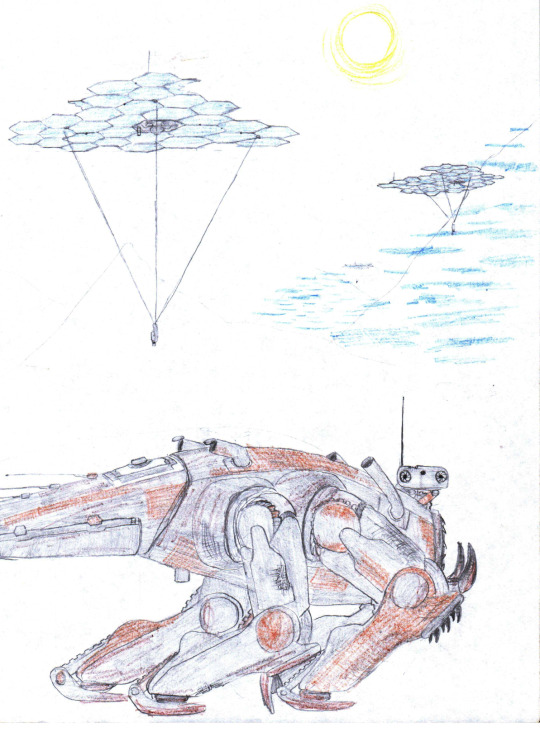
Ahhh now these are old. These drawings were made years and years before I started the story, years before I'd seen Gravity Falls or even knew the word 'fanfiction.' These were the original ideas that became the Forest's titular metallic ecosystem. You can see here the original 'lions', though these are lion-like in function only, and more closely resemble shell-less hermit crabs or perhaps blenders; they were originally imagined to be native to an Earth-like world with oxygen and water, and thus their bodies were in a perpetual state of rusting and molting and regrowing, as you see with the brown (which is a detail I ignored in the actual story, to my shame). There were also solar-powered floating cranes (a symbiosis between a hanging herbivore and a colony of hydrogen-filled solar creatures) which never made it into the story. I think I liked the final version of things better, but these early ideas had a certain unearthly character.
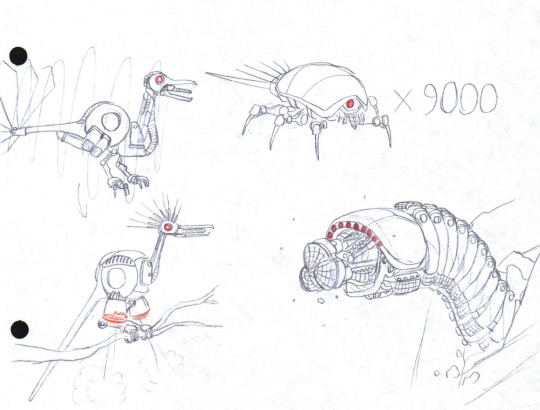
A few more creatures that were actually in the story, which for whatever reason never made it into illustrations proper. Left are a few concepts for the little birds that fly with thermal rockets, above is one of the swarming piranha bugs Dipper and Wendy encountered in the tunnels, and speaking of tunnels, there's one of the drilling worms that dug them, because you know Frank Herbert ain't gonna reference himself.

Heyyy it's Betty and Barney! I love these two. All they wanted was to live peacefully on a quaint farm. They're like metal hobbits.
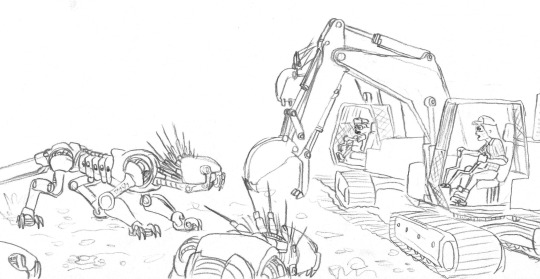
OH BABY I can't tell you how badly I wanted to have this scene somewhere in the story. It would be Dipper and Wendy in excavators fighting a couple alien lions, and the scene would be framed as some monumental, epic Pacific-Rim-style kaiju-vs-mecha fight, and I would play it 100% straight, or even straighter than straight, because the personal stakes and the amount of realism here means that I and the audience could take it much more seriously than any traditional japanese monster flick. The lumbering clumsy only-one-arm-ed-ness of the excavators puts our heroes at a distinct disadvantage, with them needing to coordinate closely together to block the much faster and more agile lions. Alas, the events of the book never played out in a way that allowed this scene to happen, but perhaps it will when I rewrite it someday. Perhaps perhaps. If I recall correctly, the idea of this scene was one of the reasons I started the story in the first place.

The finale of Wendy's story, where she confronts the mother shapeshifter in her lair, was in a state of authorial flux for quite awhile before I decided on a version of events that I liked. Here's one version of events where the mother shows up already disguised as a Time Warrior, while Sam is at gunpoint.

And another version of events where the shapeshifter is disguised as her as they fight, and you can tell who's who because the shapeshifter is mimicking a clean, perfect, idealized version of her. I'm not sure what the symbolism of that meant to me at the time, and I'm not sure why I put had in her underwear, I guess I just thought it made the scene more poignant. I wish Disney censored me like they censored the show, so we wouldn't end up with this sort of edgy, cringe nonsense.
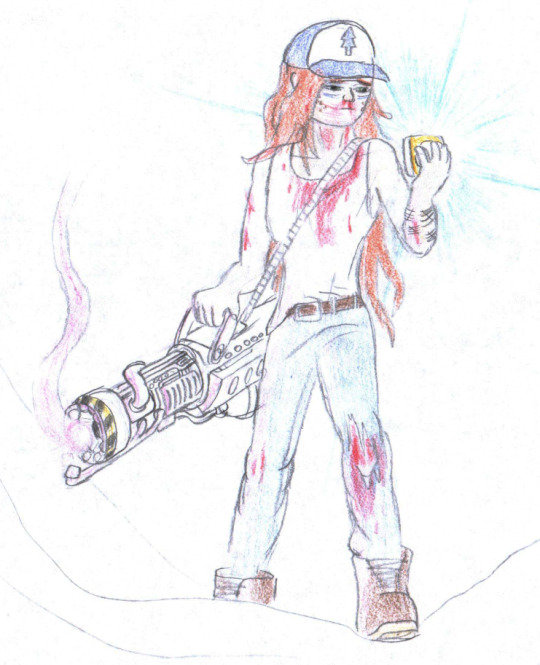

Wendy after the finale, wielding the Time Tape and the death ray, triumphant but beat up and exhausted. I liked this scene, which is probably why I drew it twice. That's a lot more blood than I think is actually realistic for a person to have outside their body (censor me Disney, please.)
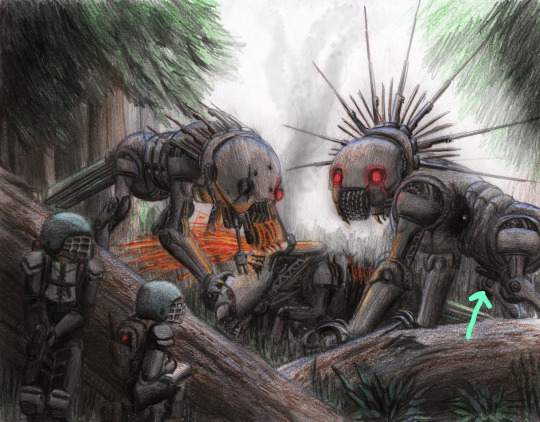
Speaking of, remember that time I posted a drawing of a penis on Tumblr dot com and got away scot free? Good times.
7 notes
·
View notes